In this tutorial we set up an online appointment schedule for a guesthouse. With small modifications this could also be used for a holiday home or a Bed & Breakfast.
Making a reservation
We refer to this calendar type this a Resource schedule: When you book a place in a guesthouse you use up a resource. If your guesthouse has multiple rooms you rent out individually, or if you want to put multiple guesthouses in a single schedule, you would define multiple resources.
In this example, an online booking system is created for a small guesthouse that offers a few rooms and requires guests to book amenities, such as towel sets.
This tutorial demonstrates the following customizations:
- using the online booking system as a simple accommodation booking tool
- sending customized email confirmations and reminders
- setting prices based on season and time left to book
You can view the result on the holiday home demo page. It’s possible to modify that page to make it appear as part of your site, but you can also integrate a SuperSaaS schedule as a so-called “widget”. A widget can appear as a small frame on your site, or as a small button, like this:
Setting up the schedule in 6 easy steps
The easiest way to set up an appointment schedule is by using a build-and-test cycle: After the initial configuration you try it out, make changes, and repeat, until it works the way you want.
Step Setting up a basic schedule using the New Schedule Wizard
Before you begin
In order to follow the steps in this tutorial, you need to create an account. It’s free and all you need is a valid email address. After you’ve created an account log in to reach your Dashboard.
Select the appropriate schedule type
Click New Schedule on your Dashboard to be directed to the New Schedule Wizard. You will first need to choose whether you want to create a Resource, Capacity or Service schedule.
Select the Resource schedule for this online booking system, where the available resource can only be booked by one person at a time.
Determine who can make changes to your schedule
For this tutorial’s purpose let’s select the option: Log in to make changes this option allows people to see the schedule but not to make any changes without an account.
Itemize resources
If you have more than one resource to be scheduled, the new schedule wizard will ask you to list them. A guesthouse may offer several rooms, in which case the second option, More than one: Multiple resources, people or places that can be scheduled concurrently is the best option to choose. In the list that appears, you can add the rooms that guests can book. Enter “Room 1” and click Add. Repeat this step for “Room 2” and click Next.
Name your schedule
The title you give to your online booking system in combination with your account name forms the URL that your clients will see in their browser when they use your schedule. Provide a short but descriptive name, such as “Rental Homes” and click Next.
You can always change the title (as well as your account name) later on but note that if you do, the schedule’s URL will change accordingly and you may need to inform your users.
Set availability
The settings in the final step provide basic constraints. After the setup finishes we will refine those in the next steps. Select a default length of “1 day” and ensure that each day of the week is available.
Clicking Finish puts your schedule online. You now have a functional online booking system that you can further configure to enable online payment, customize emails and reminder notifications and establish seasonal availability.
Step Trying out the schedule to see if it works as expected
To use your online booking system as an administrator, click Use in the menu box. This is only visible when you are logged in as an administrator.
Regular users will see the same schedule but with fewer options. You can also find Use by going to your Dashboard.
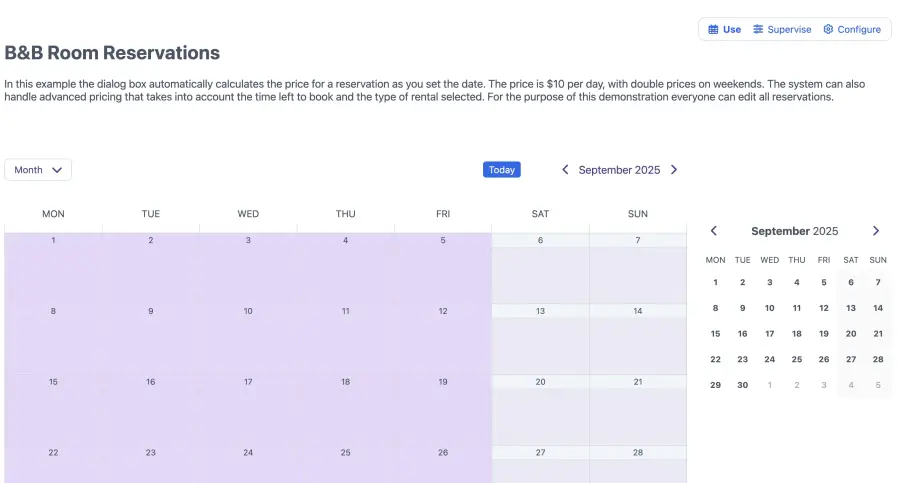
When you enter your online booking system for the first time you will be greeted by an empty schedule. SuperSaaS is incredibly flexible and can be set up to meet detailed requirements via the tabs under Configure.
Create a booking
Click anywhere in the schedule and a New reservation dialog window will appear. If this window is in an inconvenient place you can simply drag to a more suitable place on your screen.
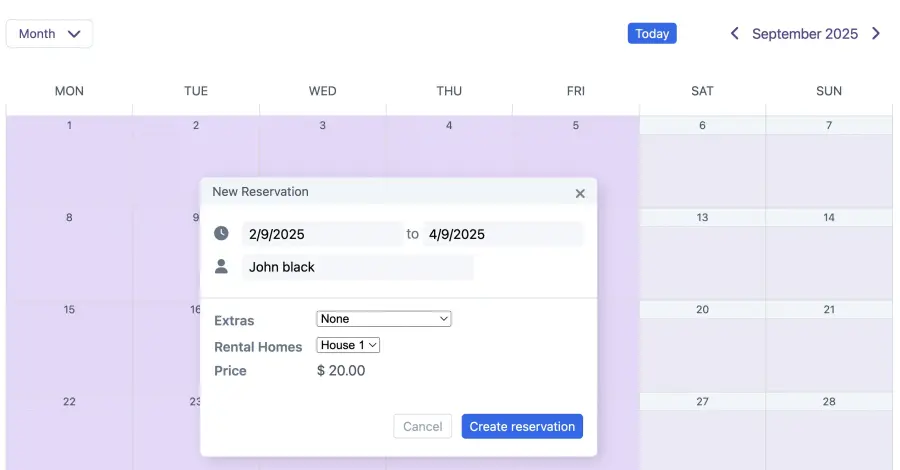
Instead of navigating to the correct date in the main calendar, you can click on When to change it. By default, the system only asks for a name and a phone number but you can add additional fields or custom forms to collect more booking details. The New reservation window will show a drop-down menu from which you can select Room 1 or Room 2.
Click Create reservation and the schedule updates to show the space in the schedule as occupied. If you would like to edit the booking, click on it to re-open the window and make changes. Be sure to click Update to save your changes.

Step Adjusting the configuration
Click Configure to go to Overview where you will see a summary of the different options you can change to suit your needs. On this page you can temporarily block the schedule or delete it entirely.
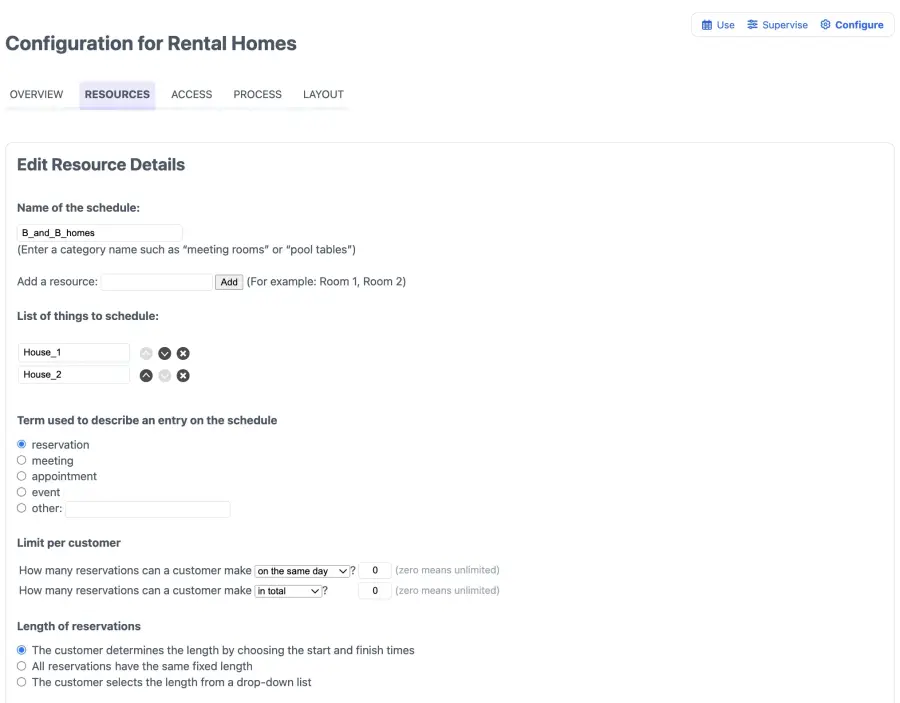
Set up the resources
The Resources tab contains the settings that define the resource(s), or “rooms” in this case, that you are scheduling for your online booking system. In the first section, you can add or delete resources. You could, for instance, add another room to the schedule. Please note that if you delete a resource, all appointments made for that resource will be deleted.
Customize terms
Under Term used to describe an entry you can select a term from the list or use a custom term to refer to bookings. For a guesthouse, the term “reservation” is more suitable. This term will be used in all dialog boxes, help text and email confirmations.
The term used to refer to a “user” can also be customized, but this setting can be found on the account wide Layout Settings page.
Define user limits
You can limit the number of bookings that a guest can make by setting the “Limit per user”. When this maximum is reached guests can only change or delete existing bookings. You can select whether previous bookings should be included in the total or whether it should only include upcoming bookings. You can also specify a separate limit for the number of bookings that can take place on the same day or in the same week.
Determine booking length
For a schedule that can be booked for whole days, your guests will want to choose how many days they would like to book.
The next 3 options determine booking length in your online booking system:
- The client determines the length by choosing start and finish time. You can provide minimum and maximum durations to limit their choices.
- All reservations have the same fixed length. Simply specify this length as a default value.
- The client selects the length from a drop-down list. When you choose this option, a selection box appears where you can list the options. The accompanying instructions and help text explain how to specify the options.
Determine price
SuperSaaS offers a broad array of payment options for your online booking system. This includes presenting prices, handling online payments via PayPal or Stripe or offering a credit system.
In addition to these payment options, you can offer various types of discounts and promotional offers. Whether you require payment at all can be configured under Process. The payment method can be configured on the Payment Setup page. More information can be found under Adding payment to your schedule.
Under Price, you can specify what you will charge your guests on your online booking system. You can choose a fixed price or base the price on the length of the booking, the day of the week or several other factors.

If you charge a daily rate for the accommodation, select Depends on date, length or resource. You can click Set up pricing to define daily and seasonal rates. For example, to raise the price by $50 in June, you would define a pricing rule that says: “Perform action: Increase price by $50” if the date is “between 6/1 and 6/30”.
Constrain times
Under Time constraints, you can specify length requirements, buffer time and start times for your online booking system. You may want guests to book whole days, instead of hours and minutes, which is the default. When you select Round times to the nearest… day the user interface will omit the display of hours and minutes. This is typically a good setting to use for a guesthouse, where people rent for days, rather than hours.
You may also want to set the minimum length of a reservation to 1 day. By default, the system treats whole days as the 24 hours running from midnight. A one-day appointment will have its beginning and end date on the same day.
If you set a buffer time to anything other than 0, the system will ensure that there is some unavailable time in between bookings. This time could for instance be used for cleaning in between bookings. The buffer time is not applied between opening time and the first booking or following the last booking, before closing time.
In the Constrain start times field, you can list the times that your clients can select as a start time. If you specify start time constraints as well as rounding times only the finish time will be rounded. In this example, enter “12:00pm” and “2:00pm” as the start time constraints.
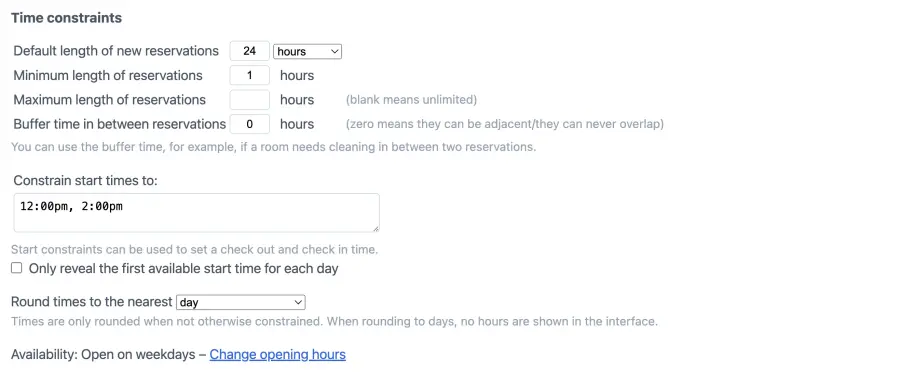
Step Building on the basic schedule
In addition to the Resources tab, you will find Access, Process and Layout options for your online booking system. These tabs include access, notification and appearance settings and detailed information can be found via the general support documentation pages.
Define the user process
The Process tab can be found via Configure. Here you can add items that may need to be reserved in addition to the room, such as a towel set. You can also configure confirmation emails and reminder notifications.
Offer extras in a drop-down menu
The customizable booking fields on the Process tab can be used to create drop-down menus in order to present a client with multiple options during the booking process. Drop-down menus are especially suitable if you offer optional services or extras that are available to the client at additional cost. A separate tutorial outlines how to set up a basic drop-down menu.
Confirmations
You can find detailed information about configuring these notifications under Configuring the booking process.
Switching views
If you offer multiple resources (for example room 1 and room 2), you might want to switch the view of the schedule. By default, the schedule monthly view is set to vertical, where appointments are shown in a vertical format. In some cases, this view may be a bit unclear for you and your customers. To avoid this, switch the monthly view of the schedule to horizontal by navigating to Configure > Layout “which views should be available?”.
Step Testing the schedule from a visitor’s point of view
Test the scheduling process from a client’s perspective to make sure you catch any errors before engaging with your clients and to ensure the appointment schedule behaves as expected. You will need to switch between administrator and user access.
Every appointment schedule has its own URL, which can be viewed via Configure under Overview. Importantly, the schedule looks a bit differently to you than it does to your users.
Your users will not see the Supervise and Configure buttons, and will typically not be able to see and change the appointments of other users. To view the schedule from your user’s point of view log out as administrator with the link in the top right menu, and then go back to the schedule page. You can speed up this process by using a second browser, or by using an anonymous browsing tab, the section “Testing the schedule you created” discusses this in detail.
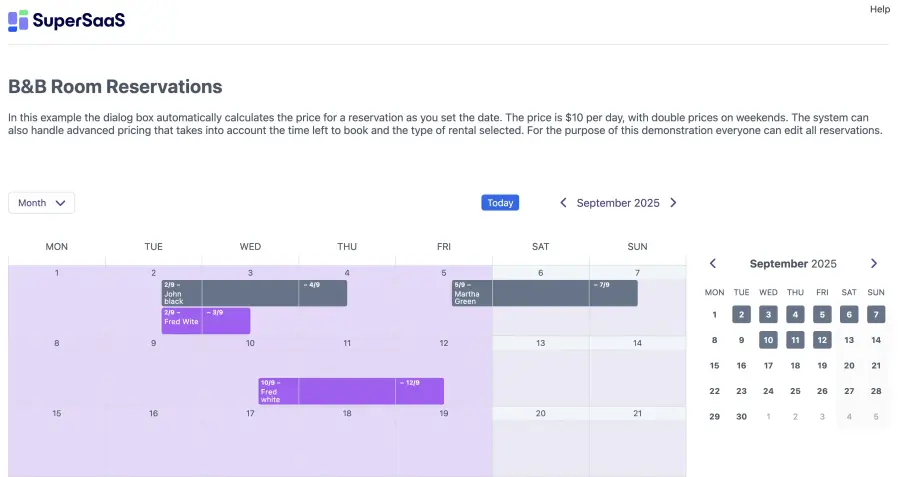
Step Integrating the registration system into your website
Once you are happy with the way your online booking system looks and have tested it to ensure that it behaves as expected for someone visiting your schedule, you are ready to direct people to it.
There are a few ways you can share your schedule:
- Put a link or button on your site that redirects people to your schedule
- Put a widget on your site that allows people to stay on your site while they book
- Add a “Book Now” button to your email and social media channels
Find out more about how to integrate a schedule in your website here.
Integrating with Airbnb and Booking.com
You can also add your SuperSaaS calendar appointments to your Airbnb and Booking.com accounts, to maintain up-to-date availability across all your channels. For Airbnb, simply go into the availability settings on your Airbnb-account. Where it prompts you to import another schedule, you can place the webcal link made available to you in the Synchronize Tab of the Supervise page on your SuperSaaS dashboard. For Booking.com, import the link in the import settings, but replace the “webcal” prefix in the address with “https” for it to work properly. The update may take a few hours to synchronize with the respective platforms.
Connecting a Nuki door lock
If you would like to use a Nuki door lock to automate access to your rental accommodation, you can let your SuperSaaS schedule create a new code each time a reservation is made. For a step-by-step tutorial and additional tips, please see our page on using a Nuki door lock.
Changing the appearance
If you’d like to change the schedule’s appearance, there are several formatting options including changing colors and adding pictures. You can use the space above the schedule to give a more elaborate description or to add instructions.
Now that you have a fully functional appointment schedule, you can find useful tips to help you on “work with your schedule day-to-day”.